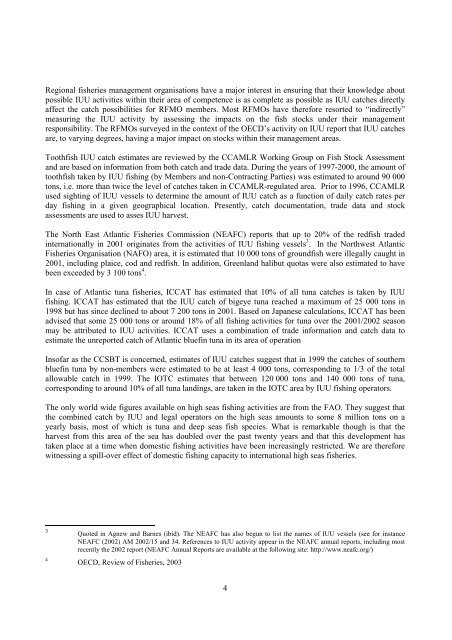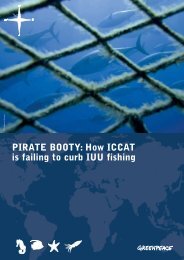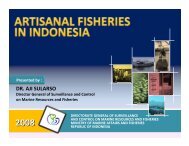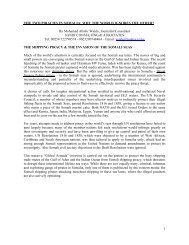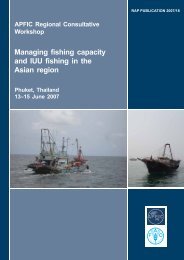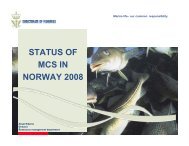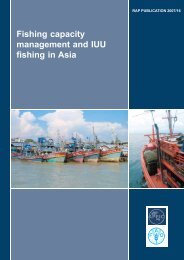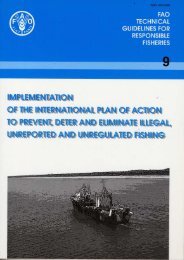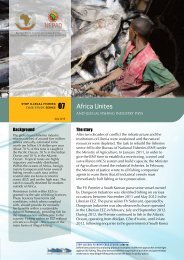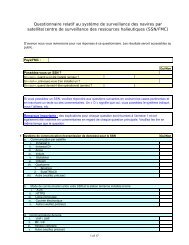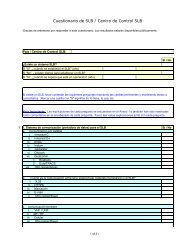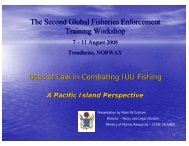1 Addressing Illegal, Unreported and Unregulated (IUU ... - OECD
1 Addressing Illegal, Unreported and Unregulated (IUU ... - OECD
1 Addressing Illegal, Unreported and Unregulated (IUU ... - OECD
You also want an ePaper? Increase the reach of your titles
YUMPU automatically turns print PDFs into web optimized ePapers that Google loves.
Regional fisheries management organisations have a major interest in ensuring that their knowledge aboutpossible <strong>IUU</strong> activities within their area of competence is as complete as possible as <strong>IUU</strong> catches directlyaffect the catch possibilities for RFMO members. Most RFMOs have therefore resorted to “indirectly”measuring the <strong>IUU</strong> activity by assessing the impacts on the fish stocks under their managementresponsibility. The RFMOs surveyed in the context of the <strong>OECD</strong>’s activity on <strong>IUU</strong> report that <strong>IUU</strong> catchesare, to varying degrees, having a major impact on stocks within their management areas.Toothfish <strong>IUU</strong> catch estimates are reviewed by the CCAMLR Working Group on Fish Stock Assessment<strong>and</strong> are based on information from both catch <strong>and</strong> trade data. During the years of 1997-2000, the amount oftoothfish taken by <strong>IUU</strong> fishing (by Members <strong>and</strong> non-Contracting Parties) was estimated to around 90 000tons, i.e. more than twice the level of catches taken in CCAMLR-regulated area. Prior to 1996, CCAMLRused sighting of <strong>IUU</strong> vessels to determine the amount of <strong>IUU</strong> catch as a function of daily catch rates perday fishing in a given geographical location. Presently, catch documentation, trade data <strong>and</strong> stockassessments are used to asses <strong>IUU</strong> harvest.The North East Atlantic Fisheries Commission (NEAFC) reports that up to 20% of the redfish tradedinternationally in 2001 originates from the activities of <strong>IUU</strong> fishing vessels 3 . In the Northwest AtlanticFisheries Organisation (NAFO) area, it is estimated that 10 000 tons of groundfish were illegally caught in2001, including plaice, cod <strong>and</strong> redfish. In addition, Greenl<strong>and</strong> halibut quotas were also estimated to havebeen exceeded by 3 100 tons 4 .In case of Atlantic tuna fisheries, ICCAT has estimated that 10% of all tuna catches is taken by <strong>IUU</strong>fishing. ICCAT has estimated that the <strong>IUU</strong> catch of bigeye tuna reached a maximum of 25 000 tons in1998 but has since declined to about 7 200 tons in 2001. Based on Japanese calculations, ICCAT has beenadvised that some 25 000 tons or around 18% of all fishing activities for tuna over the 2001/2002 seasonmay be attributed to <strong>IUU</strong> activities. ICCAT uses a combination of trade information <strong>and</strong> catch data toestimate the unreported catch of Atlantic bluefin tuna in its area of operationInsofar as the CCSBT is concerned, estimates of <strong>IUU</strong> catches suggest that in 1999 the catches of southernbluefin tuna by non-members were estimated to be at least 4 000 tons, corresponding to 1/3 of the totalallowable catch in 1999. The IOTC estimates that between 120 000 tons <strong>and</strong> 140 000 tons of tuna,corresponding to around 10% of all tuna l<strong>and</strong>ings, are taken in the IOTC area by <strong>IUU</strong> fishing operators.The only world wide figures available on high seas fishing activities are from the FAO. They suggest thatthe combined catch by <strong>IUU</strong> <strong>and</strong> legal operators on the high seas amounts to some 8 million tons on ayearly basis, most of which is tuna <strong>and</strong> deep seas fish species. What is remarkable though is that theharvest from this area of the sea has doubled over the past twenty years <strong>and</strong> that this development hastaken place at a time when domestic fishing activities have been increasingly restricted. We are thereforewitnessing a spill-over effect of domestic fishing capacity to international high seas fisheries.34Quoted in Agnew <strong>and</strong> Barnes (ibid). The NEAFC has also begun to list the names of <strong>IUU</strong> vessels (see for instanceNEAFC (2002) AM 2002/15 <strong>and</strong> 34. References to <strong>IUU</strong> activity appear in the NEAFC annual reports, including mostrecently the 2002 report (NEAFC Annual Reports are available at the following site: http://www.neafc.org/)<strong>OECD</strong>, Review of Fisheries, 20034


